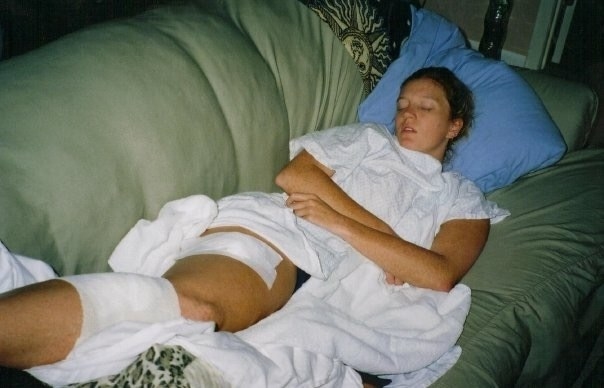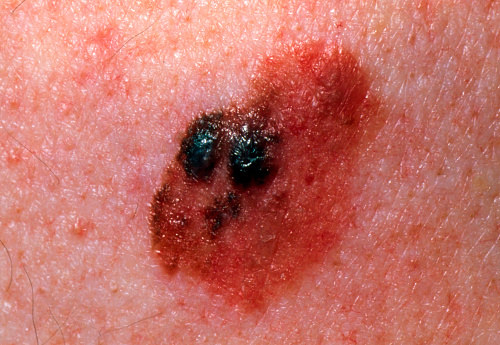 |
| Advertisement |
During her college years, Lisa Pace used tanning beds at a time when people didn’t realize the health risks, including dangerous melanomas.
Lisa Pace is a 42-year-old college basketball coach who lives in Tennessee. She was first diagnosed with skin cancer at 23.

Courtesy of Lisa Pace
Pace was born with strawberry blonde hair and very pale skin, and has a tendency to get freckles and sunburns. "Growing up, my mom would cover me up in the summers and put zinc on my nose — I was always that kid in the pool wearing a T-shirt," Pace told BuzzFeed News.
Now, at age 42, she's had dozens of surgeries — 86 in fact — to remove a variety of cancerous spots from her skin, including basal and squamous cell carcinomas, as well as the more dangerous malignant melanomas. And now she knows her frequent use of tanning beds in her teens and 20s are probably the reason why.
Pace saw a dermatologist for the first time at age 23, when she had just started working as a college basketball coach. "My mom told me that I needed to see all my doctors to get a baseline of my health," Pace said. "I had no family history of skin cancer and I hadn't noticed anything on my body."
Doctors biopsied several spots on her leg, and called a week later to tell Pace that they were melanomas. These are the least common, but most deadly type of skin cancer.
But Pace didn't fully understand the danger.
"There was no Google back then, so I didn't know what this meant — I thought skin cancer was just something they scrape off then put a Band-Aid on," Pace said. The doctors asked Pace to come in immediately, but she was on the road recruiting and put it off for weeks. "They kept calling and telling me that I had to come in now and take care of this," Pace said. When Pace finally went in, she found out she needed surgery — the first of many in the years to come.
Pace starting using tanning beds when she was 17, before it was clear that they could increase the risk of skin cancer.

Fiphoto / Getty Images / Via gettyimages.com
During her college years, Pace often used tanning beds. She started going once a week, then three to five times a week, and then almost every day, she said.
Pace said she liked how she looked with a "little color." They were heavily marketed to students and she was able to get free and discounted tanning sessions, and eventually bought an unlimited pass. Soon after, she was tanning almost every day, only taking breaks every few months — this would continue for three years.
As a college athlete, Pace often had many eyes or cameras on her while she played, which added to the pressure. "I didn't hate my skin or want to look like someone else but at times I struggled with being so incredibly pale, and whenever I had a tan people would comment and say I looked good — that stuff sticks with you," Pace said.
Indoor tanning was popular in the 1990s, especially among young women. Although tanning beds are now known to cause skin damage and cancer (they were officially classified as a carcinogen in 2009), it wasn't clear at the time, and most of her peers on campus were tanning too. "I just jumped on the bandwagon and was trying to fit in with what I thought was the norm as a college freshman," Pace said.
Even after her first surgery to remove melanomas, Pace kept tanning. "I thought skin cancer was just something that came up. I didn't know the tanning bed had caused this."

Courtesy of Lisa Pace
Pace ended up going to a specialist in St. Louis for the surgery to remove her melanomas. "They took a piece out of my upper thigh and lower calf on my right leg, and after they gave me crutches because I couldn't walk or put weight on my leg — it was frightening," Pace said. After she recovered, Pace was eager to return to coaching... and also tanning.
Pace had assumed that the melanomas on her leg were from being outside in the sun or that they had just appeared on their own. Although she was told to use sunscreen and cover up, she said she did not know she had to stop using tanning beds, too. "I don't blame the doctors because with my first surgeries it was just 'let's get this out now' and I hadn't formed a relationship with them or gotten into my history with tanning," Pace said.
So every week or so, Pace would go tanning. "I was only 23 years old. I didn't know much about skin cancer and the availability of the knowledge wasn't there like it is today with the internet," she said. "If I knew that the tanning beds caused skin cancer, there’s no way I would [have gone]."
A few months after her first surgery, Pace noticed a white spot on her cheek and went back to the dermatologist. "I remember them saying they had to take out the spot, but it was bigger than I thought — it was like a chunk out of my cheek," Pace said. At that point, Pace understood that her battle with skin cancer was not over. "I finally started talking with the nurses and doctors about using the tanning beds and that was the eye-opening moment, the turning point," Pace said.
After that, Pace said she never went tanning again and started taking better care of her skin. "I wore sunscreen all the time, long sleeves, hats — but in my late twenties and early thirties these spots just started coming out," Pace said.
"I would take a shower and look at my arms and legs or do skin checks and see all of these new spots — they were usually red places with abnormal borders or white spots, about the size of a pencil eraser," Pace said. Every time she found a spot, she would go back to the dermatologist to get it checked and in most cases, it was skin cancer that needed to be surgically removed.
At 42, Pace has had a total of 86 surgeries to remove skin cancers from her legs, arms, torso, chest, breasts, face, and back. Most have been basal and squamous cell carcinomas, which are the most common skin cancer types, and a few have been melanomas. During this time, Pace has continued to work full-time as a basketball coach. "There are days when you are just drained and sad and depressed, but you just need to find a way to get through this — coaching brings me a lot of positive energy," Pace said.
Although Pace has now gone one year without surgery, she still worries about having to cope with more skin cancers in the future.
"The main thing I want young people to understand is that I did this damage when I was a teenager and I didn't think this would ever happen to me," Pace said.

Courtesy of Lisa Pace
According to Dr. Arielle Kauvar, Pace's former doctor, It is "extremely rare" for someone to start having so many skin cancers under the age of 40, with the exception of people who have genetic syndromes that make them more susceptible to skin cancer.
"In Lisa's case, her skin cancers due to her susceptibility — having light skin and eyes — and her heavy use of indoor tanning in the past," Kauvar, dermatologist and director of New York Laser & Skin Care in Manhattan, told BuzzFeed News.
Pace also started tanning when she was a teenager, which increased her risk. Young skin isn't more resilient — it's actually more vulnerable to premature aging and skin cancer; it just takes time for these to show up. "When you're a teenager you think skin cancer won't happen to you — and it usually doesn't happen right then but it's hard to look 15, 20 years down the road," Pace said.
"The younger you are when you start having sunburns, the greater your chance of developing both non-melanoma and melanoma skin cancer — one blistering burn will double your risk of melanoma," Kauvar said. Even slow, gradual tans are still cumulative exposure to UV rays which can lead to basal and squamous cell carcinomas.
Many people, including Pace when she was younger, believe that getting a "base tan" will protect you from sun burns. However, according to Kauvar there is no evidence that "base tans" provide any degree of protection — any tan is damaging your skin.
Tanning beds are still popular in the US, even though they are increasingly linked to skin cancer — including melanoma, which can be fatal.

Dr P. Marazzi / Getty Images / Via gettyimages.com
"No one should use indoor tanning salons... it can lead to years of surgery, disfiguring scars, and possibly death from melanoma," Kauvar says. In fact, using a tanning bed before the age of 35 increases your risk of melanoma by 75 percent, according to the Skin Cancer Foundation. However, tanning beds are still popular in the US, especially among young women, despite the known health risks.
“The fact that we’re seeing so many more young females with increasing rates of both basal and squamous cell carcinoma and malignant melanoma speaks to fact that they are using indoor tanning or exposing themselves to outdoor sun without protection,” Kauvar said. Malignant melanoma is now the second most common cancer in females ages 15 to 29.
Tanning (indoor or outdoor) can also be addictive, and not just because of the way it makes you look. "Tanning has been shown to be an addictive behavior. When you sit in the sun, it generates endorphins — the 'feel good chemicals' — and this can lead to dependence or addiction," said Kauvar.
The best way to protect yourself is by using sunscreen and covering up in the sun, avoiding tanning beds, and doing routine skin checks.

Courtesy of Lisa Pace
It's never to early to start protecting your skin. There is no sure way to prevent melanoma or other skin cancers, but you can lower your risk by limiting your exposure to UV rays in the following ways:
1. Stay in the shade when outside
2. Avoid using tanning beds or lamps
3. Wear protective shirts, hats, and sunglasses
4. Apply broad-spectrum sunscreen the right way — that means at least 15 minutes before exposure and reapplying per the instructions on the bottle.
Melanoma and other skin cancers are almost always curable if recognized and treated early. The Skin Cancer Foundation recommends that you do a head-to-toe self-examination of your skin every month. You can also get skin exams from a health care professional — but you should talk to your doctor about how often you should get screened for skin cancer based on your personal and family history.
"I want young people to know that they don’t need to follow the crowd. That's something I learned because I was following a fad and following what other people were doing," Pace said. "Be comfortable in your own skin and proud."


0 comments: